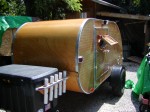I got the overall priciple down on both. Does one have an advantage over the other? Are they structurally about the same strength I am not worried about the weight difference (should be minimal I am thinking) using the same materials
Woody
vacuum bagging vs. sandwich wall building
12 posts
• Page 1 of 1
vacuum bagging vs. sandwich wall building
Woody
The Tear Jerker's, Florida Chapter Director
E-mail: [email protected]
Tear jerker chapter site http://www.tearjerkers.net/forums/
Check the SE section for gathering information
Tear Jerkers new site http://www.tearjerkers.net/forums/
Enjoying life in 12 ounce increments is what it's about
The Tear Jerker's, Florida Chapter Director
E-mail: [email protected]
Tear jerker chapter site http://www.tearjerkers.net/forums/
Check the SE section for gathering information
Tear Jerkers new site http://www.tearjerkers.net/forums/
Enjoying life in 12 ounce increments is what it's about
-

Woody - 2000 Club

- Posts: 2006
- Images: 26
- Joined: Tue Jun 15, 2004 11:07 pm
- Location: Ft. Lauderdale, Florida
Vacuum bagging is used to minimize air gaps and to ensure strong, solid contact of the glue surfaces with even force distribution across the panel or part.
I would use small screws to secure the two sides to the "joists" in the walls, then place the wall in the vacuum bag. After the epoxy has cured, the wall is removed from the bag and you can remove the screws. Patch the holes, and sand any excess expoxy off the edges.
I would use small screws to secure the two sides to the "joists" in the walls, then place the wall in the vacuum bag. After the epoxy has cured, the wall is removed from the bag and you can remove the screws. Patch the holes, and sand any excess expoxy off the edges.
-

BoilermakerFan - Teardrop Master
- Posts: 157
- Joined: Sat Sep 25, 2004 12:23 pm
- Location: Evansville, IN USA



 How much pressure do we want when gluing up with epoxy anyway? I can't find any real numbers, like "apply 1 lb/sq.ft. clamping pressure."
How much pressure do we want when gluing up with epoxy anyway? I can't find any real numbers, like "apply 1 lb/sq.ft. clamping pressure."